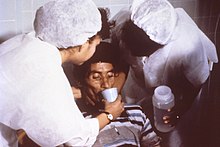| seventh cholera pandemic | |
|---|---|
 Cholera rehydration nurses | |
| Disease | Cholera |
| Bacteria strain | Vibrio cholerae biotype El Tor |
| Location | Asia, Africa, Europe, the Americas |
| First outbreak | Makassar, South Sulawesi |
| Arrival date | 1961 |
| Confirmed cases | 1,126,229 |
The seventh cholera pandemic is the seventh major outbreak of cholera beginning in 1961 and continuing to the present.[1] Cholera has become endemic in many countries. In 2017, WHO announced a global strategy aiming to end the pandemic by 2030.[2]
This pandemic is based on the strain called El Tor; it started in Indonesia in 1961 and spread to East Pakistan (now Bangladesh), by 1963.[3] It went to India in 1964, and into the Soviet Union by 1966. In July 1970, there was an outbreak in Odessa (now Ukraine) and in 1972 there were reports of outbreaks in Baku, but the Soviet Union suppressed this information.[3] Cholera reached Italy in 1973 from North Africa. Japan and the South Pacific saw a few outbreaks by the late 1970s.[3] In 1971, the number of cases reported worldwide was 155,000. But in 1991, it reached 570,000.[4] The spread of the disease was helped by modern transportation and mass migrations. Mortality rates, however, dropped markedly as governments began modern curative and preventive measures. The usual mortality rate of 50% dropped to 10% by the 1980s and less than 3% by the 1990s.[4]
In 1991, the strain made a comeback in Latin America. It began in Peru, where it killed roughly 10,000 people.[5] Research has traced the origin of the strain to the seventh cholera pandemic.[6] Researchers initially suspected the strain came to Latin America through Asia from contaminated water, but samples from Latin America and samples from Africa were found to be identical.[7]

This rapid transmission of the pathogen around the globe in the 20th century can be attributed chiefly to the major hub, the Bay of Bengal, from where the disease spread.
Cholera is caused by eating food or drinking water that is contaminated with the bacteria V. cholerae. It affects both children and adults, causing severe watery diarrhea with dehydration. But, as noted, the El Tor strain has persisted for decades to the present, causing repeated epidemics in varied locations, with 570,000 cases in 1991 alone. WHO and other authorities believe that the seventh pandemic continues.
- ^ Cite error: The named reference
epiwas invoked but never defined (see the help page). - ^ "Cholera factsheet" (Press release). Geneva, Switzerland: World Health Organization.
- ^ a b c Ahiarah L (6 May 2008). "Cholera". www.austincc.edu. Archived from the original on 2016-10-15. Retrieved 2015-11-24.
- ^ a b Hays JN (2005). Epidemics and Pandemics: Their Impacts on Human History. ABC-CLIO. p. 421. ISBN 9781851096589.
%22Seventh%20Cholera%20pandemic%22.
- ^ "Cholera's seven pandemics". www.cbc.ca. Retrieved 2015-11-24.
- ^ "Global epidemics and impact of cholera". www.who.int. Archived from the original on January 26, 2005. Retrieved 2015-11-24.
- ^ Lam C, Octavia S, Reeves P, Wang L, Lan R (July 2010). "Evolution of seventh cholera pandemic and origin of 1991 epidemic, Latin America". Emerging Infectious Diseases. 16 (7): 1130–2. doi:10.3201/eid1607.100131. PMC 3321917. PMID 20587187.